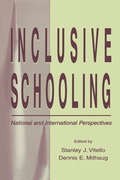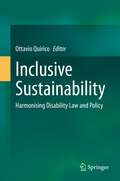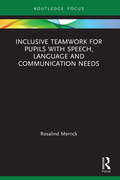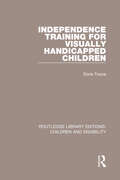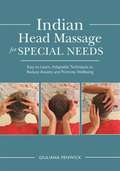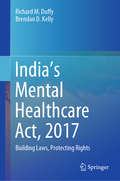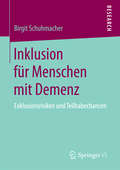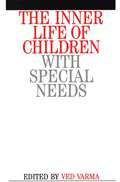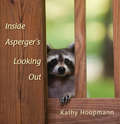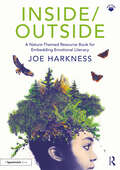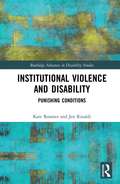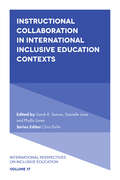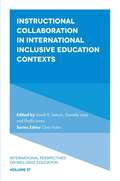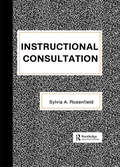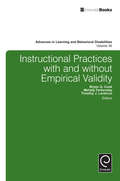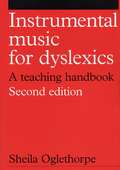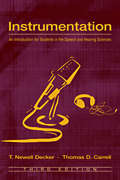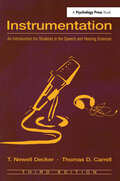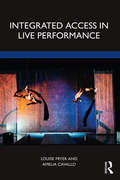- Table View
- List View
Inclusive Schooling: National and International Perspectives (Rutgers Invitational Symposium on Education Series)
by Stanley J. Vitello Dennis E. MithaugThis book provides new information on how various inclusion policies have been implemented in different schools and school districts in North America and in a range of European countries. The purpose of inclusion policy is to prevent the marginalization of people who experience unfavorable circumstances in life. It is an approach to the education of students with disabilities that is based on a commitment to what all members of a free society deserve in order to become fully participating members--a fair chance to find a meaningful place in their own communities. This book is a kind of status report on what inclusive education has achieved and what it may achieve in the future for children and youth with disabilities. It describes the philosophical, legal, and practical terrain covered by inclusion policy in general and inclusive schooling in particular. Contributors assess inclusion policy and suggest ways to reconceptualize it, bringing to their data analysis a depth of experience and knowledge about public schooling in their respective countries. Although inclusion of students with disabilities in general education classes has been embraced by politicians and educators calling for equal opportunity in our society and is being incorporated into national and international education laws, it continues to be controversial and the debate is sometimes heated. A goal of this book is to shed some light on this debate. Is inclusion mostly about student placement? Are students with disabilities attaining social and learning membership in general classrooms? Have they benefitted from inclusion? How about students without disabilities? What have been the benefits? Must learning take second priority to socialization and friendship? Are teachers getting the training they need? How do parents feel about inclusion programs? How do students feel? What kind of curricular accommodations should be made? These and other questions are addressed. This volume is based on original papers presented by the contributing authors in October 1997 at the Rutgers Invitational Symposium on Education on Inclusive Schooling: National and International Perspectives.
Inclusive Sustainability: Harmonising Disability Law and Policy
by Ottavio QuiricoIn light of the third-generation concept of ‘inclusive sustainability’, the volume explores the architecture of global disability governance and its degree of harmonisation. The book integrates socio-cultural, economic, political and legal analyses from an international and comparative perspective. The first part of the volume outlines a tripartite systematisation of disability rights for States and non-state persons. In light of essential economic considerations, the second part explores the relationship between disability and specific fundamental rights and regimes, particularly the rights to life, health, education, work and participation. The third part takes an institutional approach and focuses on the way in which the UN and regional organisations regulate disability (rectius, different ability).
Inclusive Teamwork for Pupils with Speech, Language and Communication Needs (Routledge Research in Special Educational Needs)
by Rosalind MerrickThis book provides a rationale for teaching inclusive teamwork and for understanding communication as a collective endeavour. It shows how teamwork can be taught within schools and emphasises the role that classmates have in facilitating good communication, particularly in the face of difficulty. Grounded in evidence from hours of therapy and analysis of children’s accounts of communication and children’s interactions with their peers, the book explores the components of teamwork by looking carefully at the way schoolchildren really interact. It draws on research from the fields of education, psychology and speech and language therapy to propose the framework for a programme suitable for children aged 7 to 14 years, designed to include pupils with speech, language and communication needs. The programme includes activities, a set of criteria to use as an outcome measure and examples of the way that children and young people have responded in practice. In using the inclusive teamwork programme outlined in this book, teachers have the potential to support all children in developing rapport, effective communication and problem-solving skills. Providing a framework designed to meet the needs of all learners, this book will be highly relevant reading for students of education, speech and language therapy and educational psychology, as well as speech and language therapists and practitioners in the field of education.
Inclusive Teamwork for Pupils with Speech, Language and Communication Needs (Routledge Research in Special Educational Needs)
by Rosalind MerrickThis book provides a rationale for teaching inclusive teamwork and for understanding communication as a collective endeavour. It shows how teamwork can be taught within schools and emphasises the role that classmates have in facilitating good communication, particularly in the face of difficulty. Grounded in evidence from hours of therapy and analysis of children’s accounts of communication and children’s interactions with their peers, the book explores the components of teamwork by looking carefully at the way schoolchildren really interact. It draws on research from the fields of education, psychology and speech and language therapy to propose the framework for a programme suitable for children aged 7 to 14 years, designed to include pupils with speech, language and communication needs. The programme includes activities, a set of criteria to use as an outcome measure and examples of the way that children and young people have responded in practice. In using the inclusive teamwork programme outlined in this book, teachers have the potential to support all children in developing rapport, effective communication and problem-solving skills. Providing a framework designed to meet the needs of all learners, this book will be highly relevant reading for students of education, speech and language therapy and educational psychology, as well as speech and language therapists and practitioners in the field of education.
Independence Training for Visually Handicapped Children (Routledge Library Editions: Children And Disability Ser. #6)
by Doris ToozeFirst published in 1981, this book was written to help parents and teachers to participate in child-based mobility programmes, covering the needs of visually-handicapped children from pre-school to adulthood. It gives insight into ways in which these figures can make the world meaningful to young children, as well as making them aware of the special training that is necessary to develop the social skills of daily living that a sighted child acquires through imitation. Travel techniques must be learnt to enable these children to move independently and the book describes various methods that can be used by the blind traveller. It also examines the role of physical education and dance, both of particular importance for the visually-handicapped child at school age.
Independence Training for Visually Handicapped Children
by Doris ToozeFirst published in 1981, this book was written to help parents and teachers to participate in child-based mobility programmes, covering the needs of visually-handicapped children from pre-school to adulthood. It gives insight into ways in which these figures can make the world meaningful to young children, as well as making them aware of the special training that is necessary to develop the social skills of daily living that a sighted child acquires through imitation. Travel techniques must be learnt to enable these children to move independently and the book describes various methods that can be used by the blind traveller. It also examines the role of physical education and dance, both of particular importance for the visually-handicapped child at school age.
Indian Head Massage for Special Needs: Easy-to-Learn, Adaptable Techniques to Reduce Anxiety and Promote Wellbeing
by Giuliana FenwickThis complete manual introduces unique Indian head massage techniques to help reduce feelings of stress and anxiety, calm sensory overloads, improve sleep patterns, ease frustration and boost mental, physical and emotional wellbeing in people of all ages with special needs, including Autism Spectrum Disorders. The book provides everything you need to get started, including: - A full, step-by-step, illustrated massage routine - Essential tips on how to create the perfect environment and how to approach clients with special needs - Detailed case studies - Information on anatomy, physiology and the complementary approaches to the body - Supplementary information on essential oils Developed by Giuliana Fenwick through work with her son, and extensively trialled in schools and specialist colleges, this tailored Indian head massage is perfect for anyone looking to provide additional support to people with special needs, including parents and carers, teachers, teaching assistants and other school staff, complementary therapists and any other professionals working with people with special needs.
Indian Head Massage for Special Needs: Easy-to-Learn, Adaptable Techniques to Reduce Anxiety and Promote Wellbeing (PDF)
by Giuliana FenwickThis complete manual introduces unique Indian head massage techniques to help reduce feelings of stress and anxiety, calm sensory overloads, improve sleep patterns, ease frustration and boost mental, physical and emotional wellbeing in people of all ages with special needs, including Autism Spectrum Disorders. The book provides everything you need to get started, including: - A full, step-by-step, illustrated massage routine - Essential tips on how to create the perfect environment and how to approach clients with special needs - Detailed case studies - Information on anatomy, physiology and the complementary approaches to the body - Supplementary information on essential oils Developed by Giuliana Fenwick through work with her son, and extensively trialled in schools and specialist colleges, this tailored Indian head massage is perfect for anyone looking to provide additional support to people with special needs, including parents and carers, teachers, teaching assistants and other school staff, complementary therapists and any other professionals working with people with special needs.
India’s Mental Healthcare Act, 2017: Building Laws, Protecting Rights
by Richard M. Duffy Brendan D. KellyThis book comprehensively discusses the background to the passing of India's revolutionary Mental Healthcare Act, 2017, offering a detailed description of the Act itself and a rigorous analysis in the context of the CRPD and the World Health Organization (WHO) standards for mental health law. It examines the fine balance, between complying with the CRPD while still delivering practical, humane, and implementable legislation. It explores how this legislation was shaped by the WHO standards and provides insights into areas where the Indian legislators deviated from these guidelines and why. Taking India as an example, it highlights what is possible in other low- and middle-income countries. Further it covers key issues in mental health, identifying potential competing interests and exploring the difficulties and limitations of international guidelines.The book is a valuable resource for psychiatrists, nurses, social workers, non-governmental organizations and all mental healthcare workers in India and anyone studying human rights law.
Inklusion für Menschen mit Demenz: Exklusionsrisiken und Teilhabechancen
by Birgit SchuhmacherBirgit Schuhmacher analysiert typische Exklusionsrisiken von Menschen mit Demenz und zeigt auf, wie der in menschenrechtlicher, aber auch in systemtheoretischer Hinsicht universal zu denkende Anspruch auf Inklusion für sie umgesetzt werden kann. Die Autorin untersucht den Bedeutungsgehalt der Begriffe Inklusion, Integration und Teilhabe in unterschiedlichen Disziplinen. In Bezug auf Demenz werden Ausgrenzung und Einbeziehung im (hohen) Alter, in der Familie, im Sozialraum, in rechtlicher Hinsicht und am Ende des Lebens diskutiert.
The Inner Life of Children with Special Needs
by Ved Prakash VarmaMost children have interesting interior lives that contain dreams, fantasies, hopes, fears, beliefs and their unconscious lives. This can be inferred from their preoccupations, stories, plays, games, conversations and behaviour. Because many children with special needs are emotionally confused, anxious and angry, their inner lives often contain secrets that may be permanent and damaging. These children nevertheless put out clear signals that they want to be understood.
Inside Asperger’s Looking Out (PDF)
by Kathy HoopmannInside Asperger's Looking Out follows in the best-selling footsteps of Kathy Hoopmann's All Cats Have Asperger Syndrome and All Dogs Have ADHD. Through engaging text and full-color photographs, this book shows neurotypicals how Aspies see and experience the world. Each page brings to light traits that many Aspies have in common, from sensitive hearing and an aversion to bright lights and strong smells, to literal thinking and difficulty understanding social rules and reading body language and facial expressions. At the same time, the book highlights and celebrates the unique characteristics that make those with Asperger's Syndrome special. This is the perfect introduction to the world of Aspies, told from their own perspective, for the people in their lives: including family, friends, and classmates. Those with Asperger's Syndrome will also appreciate this book for the way it shares their own singular perspectives on life.
Inside/Outside: A Nature-Themed Resource Book for Embedding Emotional Literacy
by Joe HarknessInside/Outside is a unique educational resource for those working with young people of secondary school age, providing a variety of tried-and-tested indoor and outdoor lessons and activities to promote and embed emotional literacy. The book is divided into three accessible sections: emotions and feelings; self and situation; and mental health and wellbeing; which each cover a variety of themes, from anxiety and depression, to happiness, communication, and confidence. For each theme, ‘inside’ and ‘outside’ activities are offered, with inside activities inspiring students to self-reflect and develop empathy for others, and those outside drawing heavily on nature and learning outside the classroom. The ‘outside’ activities are adaptable and have been designed to work in any available outdoor space, and all activities can be used either in standalone lessons or sequentially, with introductory tasks, group activities, and circle time discussions. With a focus on equipping students with meaningful and tangible skills to support them in the recognition, identification, and expression of their emotions, Inside/Outside will be a valuable resource for teachers, youth workers, home-educators and anyone else looking to facilitate nature connection and introspection in children aged eleven to sixteen.
Inside/Outside: A Nature-Themed Resource Book for Embedding Emotional Literacy
by Joe HarknessInside/Outside is a unique educational resource for those working with young people of secondary school age, providing a variety of tried-and-tested indoor and outdoor lessons and activities to promote and embed emotional literacy. The book is divided into three accessible sections: emotions and feelings; self and situation; and mental health and wellbeing; which each cover a variety of themes, from anxiety and depression, to happiness, communication, and confidence. For each theme, ‘inside’ and ‘outside’ activities are offered, with inside activities inspiring students to self-reflect and develop empathy for others, and those outside drawing heavily on nature and learning outside the classroom. The ‘outside’ activities are adaptable and have been designed to work in any available outdoor space, and all activities can be used either in standalone lessons or sequentially, with introductory tasks, group activities, and circle time discussions. With a focus on equipping students with meaningful and tangible skills to support them in the recognition, identification, and expression of their emotions, Inside/Outside will be a valuable resource for teachers, youth workers, home-educators and anyone else looking to facilitate nature connection and introspection in children aged eleven to sixteen.
Institutional Violence and Disability: Punishing Conditions (Routledge Advances in Disability Studies)
by Kate Rossiter Jen Rinaldi"This was several times with that damn cribbage board. I hate cribbage boards to this very day. They never beat us on the arms or legs or stuff, it was always on the bottom of the feet, I couldn't figure it out." Brian L., Huronia Regional Centre Survivor Over the past two decades, the public has borne witness to ongoing revelations of shocking, intense, and even sadistic forms of violence in spaces meant to provide care. This has been particularly true in institutions designed to care for people with disabilities. In this work, the authors not only describe institutional violence, but work to make sense of how and why institutional violence within care settings is both so pervasive and so profound. Drawing on a wide range of primary data, including oral histories of institutional survivors and staff, ethnographic observation, legal proceedings and archival data, this book asks: What does institutional violence look like in practice and how might it be usefully categorized? How have extreme forms violence and neglect come to be the cultural norm across institutions? What organizational strategies in institutions foster the abdication of personal morality and therefore violence? How is institutional care the crucial "first step" in creating a culture that accepts violence as the norm? This highly interdisciplinary work develops scholarly analysis of the history and importance of institutional violence and, as such, is of particular interest to scholars whose work engages with issues of disability, health care law and policy, violence, incarceration, organizational behaviour, and critical theory.
Institutional Violence and Disability: Punishing Conditions (Routledge Advances in Disability Studies)
by Kate Rossiter Jen Rinaldi"This was several times with that damn cribbage board. I hate cribbage boards to this very day. They never beat us on the arms or legs or stuff, it was always on the bottom of the feet, I couldn't figure it out." Brian L., Huronia Regional Centre Survivor Over the past two decades, the public has borne witness to ongoing revelations of shocking, intense, and even sadistic forms of violence in spaces meant to provide care. This has been particularly true in institutions designed to care for people with disabilities. In this work, the authors not only describe institutional violence, but work to make sense of how and why institutional violence within care settings is both so pervasive and so profound. Drawing on a wide range of primary data, including oral histories of institutional survivors and staff, ethnographic observation, legal proceedings and archival data, this book asks: What does institutional violence look like in practice and how might it be usefully categorized? How have extreme forms violence and neglect come to be the cultural norm across institutions? What organizational strategies in institutions foster the abdication of personal morality and therefore violence? How is institutional care the crucial "first step" in creating a culture that accepts violence as the norm? This highly interdisciplinary work develops scholarly analysis of the history and importance of institutional violence and, as such, is of particular interest to scholars whose work engages with issues of disability, health care law and policy, violence, incarceration, organizational behaviour, and critical theory.
Instructional Collaboration in International Inclusive Education Contexts (International Perspectives on Inclusive Education #17)
by Chris ForlinThe journey towards inclusive education and collaborative practices in different countries is complex and interdependent within each unique geopolitical landscape. Instructional Collaboration in International Inclusive Education Contexts looks at the instructional collaboration between special education and general education in international educational contexts and the role this plays in enabling inclusive education. This book provides insights into how collaborative practices are enacted in support of inclusive education in different countries around the world. Presenting a theoretical framework of instructional collaboration to provide an understanding of the commonalities, differences, and challenges of collaboration internationally. Scholars from thirteen nations each contribute towards the implementation of instructional collaborative practices and highlight how instructional collaboration is developed from teacher preparation programs, describing how this is implemented in schools to provide insight of the social and political considerations that impact on the promotion of inclusive education in the context of their country. Instructional Collaboration in International Inclusive Education Contexts is essential reading for researchers and professionals with a focus on inclusive and special education.
Instructional Collaboration in International Inclusive Education Contexts (International Perspectives on Inclusive Education #17)
by Chris ForlinThe journey towards inclusive education and collaborative practices in different countries is complex and interdependent within each unique geopolitical landscape. Instructional Collaboration in International Inclusive Education Contexts looks at the instructional collaboration between special education and general education in international educational contexts and the role this plays in enabling inclusive education. This book provides insights into how collaborative practices are enacted in support of inclusive education in different countries around the world. Presenting a theoretical framework of instructional collaboration to provide an understanding of the commonalities, differences, and challenges of collaboration internationally. Scholars from thirteen nations each contribute towards the implementation of instructional collaborative practices and highlight how instructional collaboration is developed from teacher preparation programs, describing how this is implemented in schools to provide insight of the social and political considerations that impact on the promotion of inclusive education in the context of their country. Instructional Collaboration in International Inclusive Education Contexts is essential reading for researchers and professionals with a focus on inclusive and special education.
Instructional Consultation
by Sylvia RosenfieldRecent changes in policy and law, along with advances in research, are making it necessary for an increasing number of school psychologists, special educators, and teacher consultants to develop skills in areas other than psychoeducational assessment. In response to this need, many professionals and students are expanding their careers to include the field of instructional consultation -- the synthesis of school- based consultation techniques and a solid knowledge of effective instructional practices. This book examines the major themes of instruction and gives a step-by-step outline of the consultation process from referral to the final report. Recent changes in policy and law, along with advances in research, are making it necessary for an increasing number of school psychologists, special educators, and teacher consultants to develop skills in areas other than psychoeducational assessment. In response to this need, many professionals and students are expanding their careers to include the field of instructional consultation -- the synthesis of school- based consultation techniques and a solid knowledge of effective instructional practices. This book examines the major themes of instruction and gives a step-by-step outline of the consultation process from referral to the final report.
Instructional Consultation
by Sylvia RosenfieldRecent changes in policy and law, along with advances in research, are making it necessary for an increasing number of school psychologists, special educators, and teacher consultants to develop skills in areas other than psychoeducational assessment. In response to this need, many professionals and students are expanding their careers to include the field of instructional consultation -- the synthesis of school- based consultation techniques and a solid knowledge of effective instructional practices. This book examines the major themes of instruction and gives a step-by-step outline of the consultation process from referral to the final report. Recent changes in policy and law, along with advances in research, are making it necessary for an increasing number of school psychologists, special educators, and teacher consultants to develop skills in areas other than psychoeducational assessment. In response to this need, many professionals and students are expanding their careers to include the field of instructional consultation -- the synthesis of school- based consultation techniques and a solid knowledge of effective instructional practices. This book examines the major themes of instruction and gives a step-by-step outline of the consultation process from referral to the final report.
Instructional Practices with and without Empirical Validity (Advances in Learning and Behavioral Disabilities #29)
by Bryan G. Cook Melody Tankersley Timothy J. LandrumIt is important that stakeholders are aware of practices supported as effective for students with learning and behavioral disabilities in order to provide instruction that results in improved learner outcomes. Perhaps equally important, stakeholders should also know which practices have been shown by research to be ineffective (e.g., have no, small, or inconsistent effects on learner outcomes). Special education has a long history of using practices that, though appealing in some ways, have little or no positive impact on learner outcomes. In order to bridge the gap between research and practice, educators must be aware of which practices work (and prioritize their use) and which do not (and avoid their use). In this volume, each chapter describes two practices one supported as effective by research and one shown by research to be ineffective in critical areas of education for students with learning and behavioral disabilities. Chapter authors will provide readers guidance in how to do this for each effective practices and provide concrete reasons to not do this for each ineffective practice.
Instrumental Music for Dyslexics: A Teaching Handbook
by Sheila OglethorpeInstrumental Music for Dyslexics is written mainly for music teachers. It describes dyslexia in layman's terms and explains how the various problems which a dyslexic may have can affect all aspects of learning to play a musical instrument. It alerts the music teacher with a problem pupil to the possibilities of that pupil's having some form of dyslexia. Although Sheila Oglethorpe is primarily a piano teacher the general principle behind most, if not all, the suggestions is such that they can be adapted for use by other instrumentalists. The book presents ways in which the music teacher can contribute to the self esteem and thereby the general welfare of the dyslexic pupil who is often musically gifted and has much to offer. The book will also be of interest to dyslexia specialists who have hitherto directed their concentration towards the language-based problems of the dyslexic.
Instrumentation: An Introduction for Students in the Speech and Hearing Sciences
by T. Newell Decker Thomas D. CarrellWhile keeping the scope and essential thrust of the original book unchanged, this third edition has been updated to reflect the latest technology. For instance, important revisions have been made to a few chapters, while one chapter has been eliminated and replaced with a newer chapter dealing with recent developments in digital and consumer electronics that are relevant to laboratory instrumentation. The authors hope the readers of this text will be more confident with instrumentation and more willing to experiment with it, as well as be able to appreciate the possible ways that electronic instrumentation can be used in their work. The book was written with the undergraduate in speech and hearing sciences uppermost in mind. Instead of detailed information about individual pieces of instrumentation, a more basic and broad descriptive approach has been used. Throughout, examples have been provided regarding how certain pieces of equipment can be used in the clinic or laboratory. One or more step-by-step exercises are included at the end of certain chapters to help students obtain hands-on experience and equipment flowcharts help reinforce the exercise. Students who complete this book will have a basic understanding of the major pieces of instrumentation in the hearing and speech clinic/laboratory.
Instrumentation: An Introduction for Students in the Speech and Hearing Sciences
by T. Newell Decker Thomas D. CarrellWhile keeping the scope and essential thrust of the original book unchanged, this third edition has been updated to reflect the latest technology. For instance, important revisions have been made to a few chapters, while one chapter has been eliminated and replaced with a newer chapter dealing with recent developments in digital and consumer electronics that are relevant to laboratory instrumentation. The authors hope the readers of this text will be more confident with instrumentation and more willing to experiment with it, as well as be able to appreciate the possible ways that electronic instrumentation can be used in their work. The book was written with the undergraduate in speech and hearing sciences uppermost in mind. Instead of detailed information about individual pieces of instrumentation, a more basic and broad descriptive approach has been used. Throughout, examples have been provided regarding how certain pieces of equipment can be used in the clinic or laboratory. One or more step-by-step exercises are included at the end of certain chapters to help students obtain hands-on experience and equipment flowcharts help reinforce the exercise. Students who complete this book will have a basic understanding of the major pieces of instrumentation in the hearing and speech clinic/laboratory.
Integrated Access in Live Performance
by Louise Fryer Amelia CavalloTwelve per cent of UK theatregoers have a disability. This compares with 18% of the UK’s adult population. Directors can help build audiences as diverse as the population at large by making their art accessible to all. Live performances are increasingly being made accessible to people with sensory impairments not only to satisfy equality laws and the requirements of funding bodies, but also in the interest of diversity and as a catalyst for creativity. But how do you ensure you don’t throw out the access baby with the artistic bathwater? This book draws on the results of the Integrated Access Inquiry: Is It Working? A qualitative study with 20 theatremakers from around the UK, it was commissioned by Extant Theatre – the UK’s leading company of blind and visually impaired people, and combines feedback from disabled audiences with advice from the creative teams who have experimented with integrating access. It discusses the challenges and opportunities of working with disabled actors and building in audience access even before rehearsals begin. It offers strategies, case studies and a step-by-step guide to help creative people integrate access into their live performance for the benefit of all.
